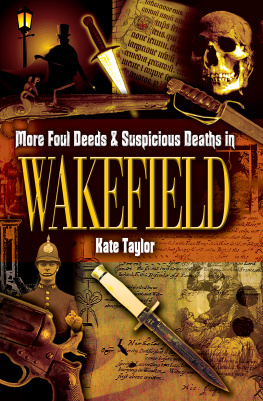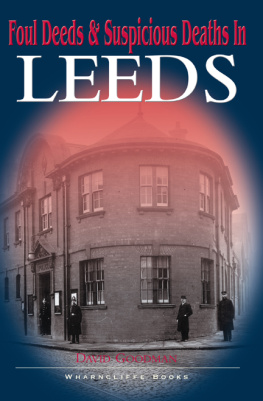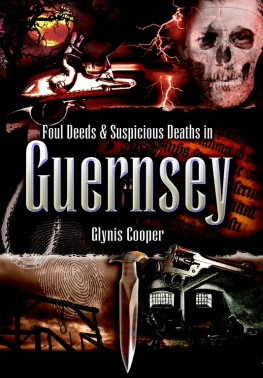First published in 2003
and reprinted in 2013 by
True Crime
an imprint of
Pen & Sword Books Ltd
47 Church Street
Barnsley
South Yorkshire
S70 2AS
Copyright Geoffrey Sadler 2003, 2013
PAPERBACK ISBN: 978 1 90342 530 5
PDF ISBN: 978 1 47382 954 1
EPUB ISBN: 978 1 47382 868 1
PRC ISBN: 978 1 47382 911 4
The right of Geoffrey Sadler to be identified as Author of this
work has been asserted by him in accordance with the Copyright,
Designs and Patents Act 1988.
A CIP catalogue record for this book is
available from the British Library
All rights reserved. No part of this book may be reproduced or
transmitted in any form or by any means, electronic or mechanical
including photocopying, recording or by any information storage and
retrieval system, without permission from the Publisher in writing.
Printed and bound by CPI Group (UK) Ltd, Croydon, CR0 4YY
Pen & Sword Books Ltd incorporates the Imprints of
Pen & Sword Aviation, Pen & Sword Family History, Pen & Sword Maritime,
Pen & Sword Military, Pen & Sword Discovery, Pen & Sword Politics,
Pen & Sword Atlas, Pen & Sword Archaeology, Wharncliffe Local History,
Wharncliffe True Crime, Wharncliffe Transport, Pen & Sword Select,
Pen & Sword Military Classics, Leo Cooper, The Praetorian Press,
Claymore Press, Remember When, Seaforth Publishing and Frontline Publishing
For a complete list of Pen & Sword titles please contact
PEN & SWORD BOOKS LIMITED
47 Church Street, Barnsley, South Yorkshire, S70 2AS, England
E-mail:
Website: www.pen-and-sword.co.uk
Contents
Introduction
We didnt use to have violence in those days.
It is a statement we have all become familiar with by now, the resigned comment delivered with a sad shake of the head by some senior citizen friend or colleague, harking back to a bygone paradise and convinced that present-day society is on its way to Armageddon. Nowadays it is often all too easy to agree with them as we hear of neighbours and relatives having their houses burgled, their cars stolen and trashed, and old folk afraid to venture on to streets roamed by violent gangs or druggies out for a fix. And if these problems pass us by, television and the newspapers are always ready to regale us with horror stories of unfortunates battered and tortured in their homes by sadistic psychopaths, or children abducted and murdered by paedophile killers. We are right to be appalled at all of these crimes, but that is no excuse for pretending they never happened before. Believe me, they did. Violence is deplorable, but it is nothing new.
Turn to the newspapers of previous ages, or read back into the history books for even earlier centuries, and the similarities are startling. People in the fifteenth, eighteenth and nineteenth centuries were convinced they lived at the height of an unprecedented crime wave, in an age where the country was going to the dogs, and where something had to be done to prevent total anarchy. I shall never forget reading through the pages of the Derbyshire Times and Derbyshire Courier issues for the 1850s and 60s, and being genuinely shocked to encounter case after case of crimes we tend to regard as modern aberrations. Child abduction and abuse, domestic violence, gang rapes, garottings, suicides and murders featured regularly in these pages. Read the Derby Mercury from 1732 onwards, and the story is much the same.
Chesterfield is the second largest town in Derbyshire, and the largest in the north of the county. A thriving, attractive market town surrounded by scenic landscapes, it presents a pleasant face to visitors, but a study of its past reveals that it has often been a dangerous place to live in. From medieval times to our own day Chesterfield and its neighbouring towns and villages have seen desperate encounters and shocking crimes, with suicides and brutal murders that have frequently achieved country-wide notoriety.
This book explores the darker side of Chesterfield and its outlying areas, shedding light on a catalogue of crimes, some of them relatively little known, others still claiming media attention. From the double murder at Chesterfields parish church on 1 January 1434 we follow a blood-stained path that takes in the multiple executions at Tapton Bridge, and the savage punishment meted out to the members of the Babington plot and the 1817 Pentrich Revolution. The reader is witness to the murder of the luckless runaway couple at Winnats Pass in 1758, the fate of the victim of Derbyshires last gibbet in 1815, and stands with gallant superintendent Dennis Gorman in his vicious hand-to-hand battle with the Sothall sheep-stealer in 1870. The bloody thread of violence runs on to the grim Victorian yards and alleys of central Chesterfield, with their batterings, poisonings and razor murders.
I have been fortunate to have worked for the last seventeen years in the Chesterfield Local Studies Library, and to have access to its considerable resources. The library holds microfilm copies of the Derby Mercury, Derbyshire Courier and Derbyshire Times, together with a substantial file of cuttings from the Sheffield Star, which between them cover a period from 1732 to the present day. These newspapers report on crimes and police investigations, often with detailed accounts of trials and, from the mid-nineteenth century onward, the findings of coroners inquests, where the causes of death are more thoroughly explored. They have provided me with the basic tools for my research. Standard works on crime and punishment in Derbyshire in the library stock have also provided valuable information, among them accounts of the trial of Antony Babington and of the Pentrich defendants, Annals of Crime in the Midland Circuit, and The Complete Book of Emigrants in Bondage, which lists persons transported to the American colonies prior to 1776, and gives instructive details of their offences; I have also found useful facts in periodicals such as the Derbyshire Life & Countryside and Reflections magazine.
I would like to express my thanks to my colleagues in the Chesterfield Local Studies Library and County Local Studies Library, Matlock, to Derbyshire Library Service for use of their images, to Philip Cousins for the kind loan of information and to the Ordnance Survey for permission to reproduce Old County Series maps. Special thanks must go to my good friend Dennis Middleton, who has toured virtually all of north Derbyshire with me to take the excellent photographs shown in the text, to Brian Davis for reproduction of the cover illustration, to Alun Waterhouse for his continued help in negotiating the new technology, and to Ann Krawszik and Sue Crabbe for the kind loan of additional photographs. Finally my thanks go to Brian Elliott and Wharncliffe Books for inviting me to take part in this project, and for their help and advice in making it happen.
Sources
1. Copies of local newspapers including the Derbyshire Times, the Derbyshire Courier, the Derby Mercury, and the Sheffield Star.
2. Anon. Annals of Crime in the Midland Circuity 1859.
3. Christian, Roy. The Last of the Peasants Revolts, 8 June 1967, Country Life.
4. Coldham, Peter Wilson. The Complete Book of Emigrants in Bondage 1614-1775, 1988.
5. Cooper, William Durrant. Notices of Anthony Babington of Dethick and of the Conspiracy of 1586, Reliquary Vol 2, 1861-62.
6. Large, J A. Stories of the Derbyshire Dales, 1997.
7. Pentrich Historical Society. Pentrich Revolution Trail, 2000.
8. Sitwell, Sir George. The Story of the Sitwells, unpublished galleys in Chesterfield Local Studies Library.
9. Society for the Prosecution of Felons, 1744
Next page













